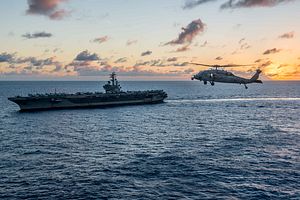Two nuclear-capable Tupolev Tu-95MS strategic bombers of the Russian Aerospace Force were intercepted by U.S. F/A-18 Hornet fighter jets as they were approaching the U.S. Navy nuclear-powered Nimitz-class aircraft carrier USS Ronald Reagan in the Sea of Japan, according to two U.S. defense officials.
CNN first reported the incident on November 1. It was later confirmed by U.S. Navy officials speaking to Military.com. The interaction between the Russian bombers and U.S. aircraft was “safe and professional” and proceeded without incident, according to a U.S. Navy spokesperson. The intercept took place about 128 kilometers from the carrier.
It is unclear how many F/A-18 fighter jets the USS Ronald Reagan scrambled to intercept the bombers.
As I reported earlier this week, the Russian Ministry of Defense (MoD) acknowledged in a October 30 statement that U.S. aircraft and Japan Air Self-Defense Force (JASDF) fighter jets escorted “missile-carrying Tupolev-95MS strategic bombers during their flights over international waters of the Sea of Japan and the Pacific Ocean.” However, in the statement, the Russian MoD misidentified the U.S. aircraft as belonging to the U.S. Air Force.
“Two strategic bombers Tupolev-95MS of Russia’s Aerospace Force have carried out routine flights over international waters of the Sea of Japan and the western part of the Pacific Ocean,” the statement read. “At certain sections of the route the Tupolev-95MS crews were accompanied by a pair of F-18 fighters (of the U.S. Air Force), and a pair of F-15, F-4 and F-2A fighters (of the Japanese Air Force).”
The Russian bombers were accompanied by Su-35S fighter jets.
The Japanese Ministry of Defense (MoD) confirmed the intercept in a statement noting that Japanese airspace was not trespassed by the Russian bombers.
“The Tu-95MS is an improved variant of the older Tu-95, a Soviet-era four-engine, long-range, turboprop, strategic bomber that can be armed with a wide range of weapons including stand-off nuclear-capable cruise missiles,” I explained elsewhere.
Two Russian Tupolev Tu-142 maritime reconnaissance and anti-submarine warfare aircraft flew within one nautical mile of the USS Ronald Reagan in October 2015, prompting the dispatch of four F/A-18 Super Hornets from the carrier to intercept the Russian planes.
The USS Ronald Reagan recently completed a naval exercise in the waters off the Korean Peninsula with the Republic of Korea Navy (ROKN). The ship departed the South Korean port of Busan after a four-day port visit on October 26, and has been operating in the Sea of Japan amid increasing tensions between the United States and North Korea over its ballistic missile and nuclear tests.
The carrier and its escort is slated to join two other carrier strike groups — the USS Nimitz and USS Theodore Roosevelt — in a rare joint military exercise in the Western Pacific later this month. The USS Ronald Reagan carrier strike group, operating out of Yokosuka Naval Base in Japan’s Kanagawa Prefecture, is the U.S. Navy’s only forward-deployed carrier strike group in the Asia-Pacific region.

































